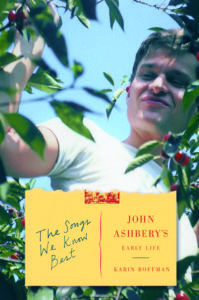
At the age of eighty-nine, John Ashbery has enjoyed, within his lifetime, what is arguably the greatest acclaim of any North American poet of his generation. Beginning with W. H. Auden’s selection of his 1956 collection, Some Trees, for the Yale Younger Poets Prize, Ashbery has received nearly all the major awards available to poets. In the historically fractured poetry world, he’s long been a downright mingler, with his work celebrated and admired to equal acclaim across the aisles of “academic” and “experimental” poetry. As enigmatic and obtuse as his poetry is commonly perceived to be, he nevertheless continually appears in many a poetry reader’s must-read pile. And he’s the constant darling of literary scholars, embraced from the earliest beginnings of the Language crowd, and anthologized into the Harvard-backed canon of dame Helen Vendler. There simply is no other American poet who enjoys such welcoming adoration from all corners.
Despite his renown, the details of Ashbery’s personal life have long remained guardedly private. Of course there is the notoriety of his role among the poets and painters of the New York School, yet even there his presence is often at the fringe of the lives of the painters, or arrives via his close friendship with the North Star poet of the coterie, Frank O’Hara. In any case, more often than not, it is either attention to his work or consideration of artistic representations of his likeness that have taken predominance over biographical scenes from his life.
Reading his work is no help. I’ve long found that when reading Ashbery’s poetry it’s easy to lose track of just who the poet is. Ashbery’s work is a sort of meta-poetry commenting upon the habit of poetry’s tendency to dwell upon its own concerns, lost to its own abstracted plight over locating some meaningful resonance for existence. The manner in which the poems convey information gives the reader a distinct sense that their message is delivered as if from a vantage point quite distant, and removed from the immediate reality of any one person’s possible life. Reading his poems, you begin to feel that maybe, just maybe, you are writing the poems yourself. Ashbery even entitled his 2000 collection Your Name Here. The notable individuality of the work is found in its challenging multiplicity of perspective. Ashbery exposes reader’s assumptions as arbitrary and mundane, opening fresh paths of thinking: “It’s not the background, we’re the background, / On the outside looking out.” These lines are from Ashbery’s poem “But what is the reader to make of this?,” a portion of which appears on the back wrappers of Karin Roffman’s The Songs We Know Best: John Ashbery’s Early Life (Farrar, Straus and Giroux, 2017), and are thus entirely more fitting than any set of blurbs for capturing the essence of Roffman’s subject.
Roffman’s biography, then, steps into what has been more or less vacant space, and her apt portrait of the elusive poet is sure to please. She generously fills the biography with an encapsulating account of the poet’s early years, from his childhood, his school years, and into early adulthood.
Although forever New York City-affiliated, Ashbery grew up on a small family farm in the northwestern corner of New York. He had a healthy, loving relationship with his grandparents, spending cherished summers of his childhood with them in the tiny hamlet of Pultneyville on the shores of Lake Ontario. During these summers, he quickly and easily fell into a bibliophile’s habit of solitude in cozy rooms. He never quite connected with his outdoorsy, physically active father. It appears his father suspected Ashbery’s homosexuality, although the two of them never spoke directly about it. The young poet’s lack of interest in the family farm only further doomed any chance of warmth between father and son. Ashbery’s relations with his mother were comparatively warmer, although they reached a chilling point when she was confronted with evidence of his homosexuality: “The more she talked, the more hysterical she became. John made her promise not to tell his father, and after her outburst, she never mentioned the subject again.”
Further complicating the emotional chasm between the young poet and his parents was the early, unexpected death of his younger brother, Richard, from leukemia. (The seriousness of Richard’s illness was kept from Ashbery, and his brother’s death came as a traumatic shock to him.) Richard’s predilections for robust physical activity had often been held in contrast to Ashbery’s own inclinations and habits. According to Roffman, “[o]nce, John overheard [his mother] refer to his left-handedness—‘at least he eats right-handed!’—suggesting, he thought, that she found him slightly odd. He tried to keep out of the way of his father’s temper, and to steer clear of his noisy, athletic, energetic brother.” Regardless of emotional strains in their relationship, however, the Ashberys supported John and maintained the appearance of family wholesomeness. As a kid, Ashbery enjoyed frolicsome adventures with a close-knit group of pals, enjoyed a small-time celebrity stint on the quiz show, Quiz Kids, and generally had a well-rounded childhood. He also began at a young age writing poems, to some notoriety within the family’s social circle.
By the time Ashbery went off to private school at Deerfield Academy, a move initiated by a family friend acting as benefactor, he was well on his way to pursuing his interests in poetry and the arts. He was also on the verge of a burgeoning awareness of his sexuality. It was around the time of his graduation from Deerfield that a classmate, with whom he roomed and continued to have an on-again-off-again friendship, decamped with Ashbery’s own poems. Originally this duplicitous act was intended only for a “special poetry class,” but the situation quickly escalated when the instructor of the class, local poet David Morton, recommended the poems to editors at Poetry magazine in Chicago. This rather fascinating episode led to Ashbery, now a freshman at Harvard, unexpectedly discovering two of his own poems (“Poem,” known as “Seasonal,” and “Lost Cove”) published in the November 1945 issue of Poetry, attributed to one “Joel Michael Symington,” an alias of his betrayer. Such personal trials, though hard-hitting, only seemed to confirm the fated path of the poet toward growing recognition of his artistic skill.
Roffman’s rendering of Ashbery’s early life has such spirited lift to its coursing byways and biographical thoroughfares that it comes as a disappointment—inevitable in an “early life” project—when her narrative ends in the fall of 1955, with the twenty-eight-year-old poet’s departure to France. At this point in Ashbery’s life, publication of Some Trees was imminent. He had just received a Fulbright. He recognized that his friendships in New York City would always remain at the center of his imagination, yet he was eager for “the drama of a new shore.”
According to Roffman, both Ashbery and his partner, David Kermian, “remained energetic and good humored” over six years of cooperating with her throughout the writing of the biography. Ashbery filled in details during extensive interviews, and gave Roffman access to his correspondence and contact information for friends and family. Roffman also successfully followed up on several leads of her own. There are plentiful photos of a young Ashbery, with family and friends alike, appearing throughout the book, and Roffman thoroughly notes all her references and sources.
The Songs We Know Best never answers the riddle of how one becomes John Ashbery, celebrated poet. Not that Roffman’s biography allows Ashbery to disappear behind the facts of his life the way he does within his poems; her diligence in fleshing out the poet’s past leaves little chance of that. Certainly reoccurrence throughout the book of lines such as, “John felt solitary and unhappy” align with the assumption that poets are born of solitude and extended periods of morose doldrums. But the unknowable reality of just what occurs in an individual that leads to, in this case, Ashbery’s pithy, wisdom-wielding art, remains, as it should, a mysterious mix of happenstance and self-declared endeavor, shielded by the winsome tones of the work itself.
Nor does Roffman’s account tell us where to find the poet in the poems. To be fair, it’s impossible to know whether Ashbery intends to vanish into his work the way he does. It may simply be that that’s how the poems arrive to be written. Still, however much Roffman draws upon Ashbery’s writing to demonstrate how this or that bit may reflect specific autobiographical details, the work itself so engulfs any possibility of certainty within its ambiguous murk that the only true exegesis is one of never-ending possibility. Roffman’s biography, grounded by her close reading of several poems, suitably returns us to appreciation of that work.





